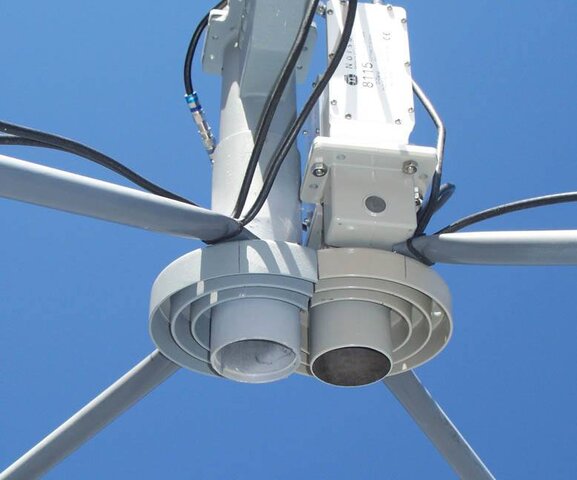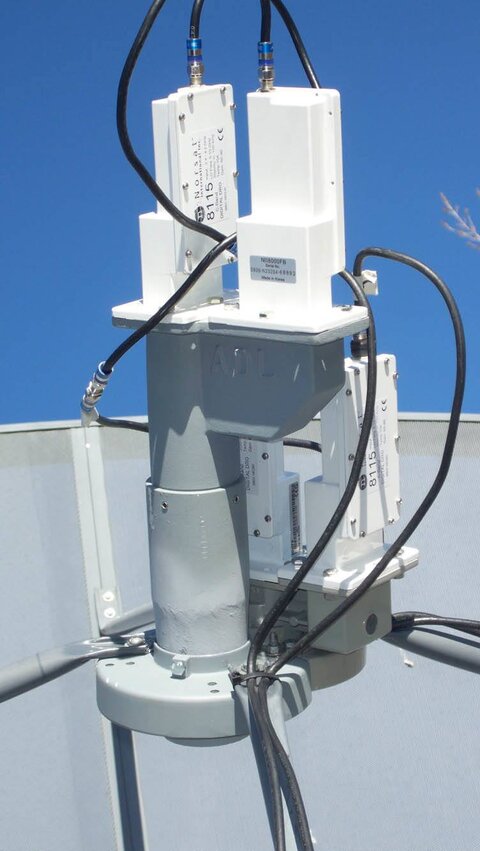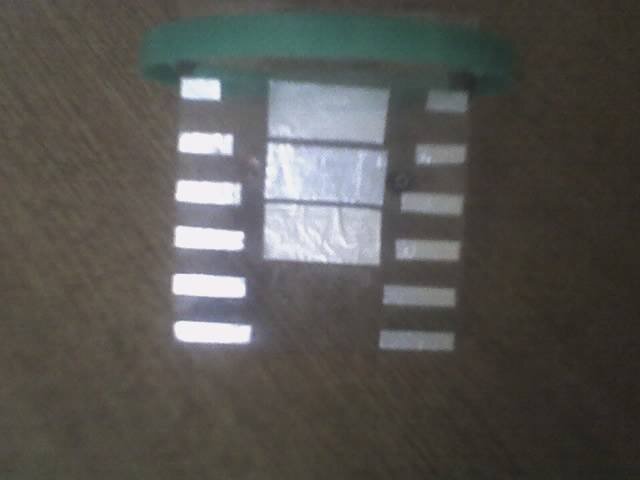Nothing had gone according to plan over the weekend with the kids, so a couple of hours before sundown I was determined to rescue something to show for it on the FTA side. I've been playing musical feeds on my BUDs over the past few months trying to figure out where everything best fit. That left a single orthomode feed on the 3.2 m for the absolute best CNR, a single ortho on the 3 m as a secondary, a single ortho on the 2.3 for easier feeds, and a modified dual ortho with a quad universal Ku on the 1.8 m for easy C-band and tough Ku-band feeds.
Unfortunately I still had an orphaned ADL single orthomode C-band circular feed in the project box. Originally I picked up the 2.3 m for this purpose, and although it did well, I wanted better reception on the weakest signals. Part of the problem may be that the ADL circular feed is designed for a fixed f/D. You can only move the scalar over a very narrow range, and not enough to exactly match the 2.3 m's f/D of 0.35. Even before that I had wondered if I could somehow get it to work on my Winegard 3 m Pinnacle, which has a ridiculously low f/D of 0.278. This has become my problem child dish, not because of any inherent flaw, but because no feed I've ever tried on it matched well out of the box. Every feed that's been on it has been modified. When I talked to a knowledgeable dealer about possibly using this feed on the Pinnacle, all I heard was him rolling on the floor laughing. That stung, so guess what I decided to do yesterday.
It wasn't enough to prove the ADL circular feed could work well on a deep dish. After all the feedhorn and waveguide dimensions are fairly well suited for such an application, as the diameter is a bit larger than most of my orthos. If I merely switched it with the linear ortho already on the 3 m, I would still have an ortho with two Norsat 8115s collecting dust in the project box. Ok, it would take a little less space than the monster ADL circular. Instead I was determined to get both working well on the same dish.
Logic would say that a multifeed C-band setup would be a better fit for a shallow dish. The longer focal length provides a smaller angle offset between the feeds, meaning each is closer to the paraboloid's focus. But somebody seems to have had a monopoly on much of Colorado's C-band market, because all I keep finding for free are deep dishes. That's fine in the end because I can generally get higher CNRs on deep dishes with a little work. There is also the question of whether to center one feed and have the other offset. Here's a little math that explains my choices.
A typical C-band feed has a mouth diameter around 2.5" and a scalar ring diameter of say 6". The Pinnacle's focal length is about 33". If I simply attached the scalar rings side-by-side, the feed centers would be 6" apart and that would be a 10.4 degree offset on the Pinnacle. If one feed was centered, the offset feed would have a loss of more than 3 dB. That's horrible because the 3 m would be acting like a 2.1 m dish in terms of sensitivity. Recall I wanted more gain than my 2.3 m could offer. But if instead both feeds were each offset from center by 5.2 degrees, there would only be around a 1.25 dB loss. So this is heading in the right direction.
If I overlapped the two scalars, the feed centers would be about 4.25" apart. That would be a 7.4 degree offset on the Pinnacle. If both feeds are offset by the same amount, each would experience around a 0.5 dB loss. Not perfect, but getting there. The last step is to hack the scalars so the feeds are right next to each other. With a 2.5" separation and offset by the same amount, the two feeds will be 4.3 degrees apart and the loss might get below 0.25 dB for each. That sounded pretty good. I don't mind a little math if it saves me 3 dB. A lot easier than putting up a 4.2 m dish.
The first step was to solve the circular feed's f/D problem. It turns out the feed diameter steps up a little bit as one goes from the front to the back of the feed. This step fixes the scalar in place and allows the back of the waveguide to rotate so one can align the 1/4 wave plate with respect to the LNB probes. The ADL feed is claimed to employ a much less lossy 1/4 wave plate than the dielectric inserts normally supplied with low end C-band feeds. It certainly looks very nice and it should be considering the cost of the ADL circular feed. I was a little concerned about how the step would affect the 1/4 wave plate mounting, but as the slot for it is already machined into the thinner front part of the feed, this didn't look to be a problem.
I've got lots of tools but no lathe, and I realized finding a friend with one would exhaust the remaining daylight hours. So out came the grinder and I took off maybe 2.5" of the step towards the back of the waveguide. This allowed the scalar to slide far enough back to better match the Pinnacle's f/D. It also revealed a lack of coordination by highlighting my less than perfect machining with a 'hand lathe'. Some spray paint did a decent job in calling less attention to this than a shiny aluminum feed mouth.
For such simple feeds, there are a lot of things to get in the way when you slap two next to one another. I finally decided where to mark the lines and hack off a slice from each scalar ring. This is shown in the photos, and allows me to clamp each feed with the set screw in its own scalar, while allowing me to essentially butt the two feeds against one another. I cut two strips from a thick aluminum plate and used these to bolt the two scalars together. A little English on these plates allowed me to align the feed mouths and toe them in slightly to compensate for the offset. After that I had to add some new holes to attach the dish's support arms. This was the tightest part because there isn't much clearance for the arm than attaches to the scalar underneath one of the linear LNB mounts.
I was moving fast because the sun was going down, and found I had to saw some bits off the support arms to could get the feeds close enough to the focal distance. I ended up a tiny bit farther away than I was shooting for, but certainly good enough to test. I had to eyeball the alignment and was able to make a few sighting checks to make sure the feeds were close to center before it got too dark to do anything.
After I was excused from dinner it was time for some quick functional tests. It was clear both feeds were working pretty well. Just before I took down the Pinnacle single ortho, I pointed the 3 m and 3.2 m dishes at a very strong transponder. The 3.2m read 0.5 dB more CNR, which is almost exactly what it should be. After dialing in the best new motor position for the linear feed, it was still 0.5 dB below the 3.2 m. That was stunning because I planned to mess around for hours doing the fine tuning and still expected to lose some gain from the single feed reference point. At best I figured there would be a 0.25 dB loss. I haven't thought about this much, but perhaps the larger 'Siamese scalar' might be improving the CNR and compensating for the slight offset loss. I don't have as good a reference for the circular feed, but right off the top it got 50% more transponders logged off 40.5 W than did the 2.3 m, and all of them were hot. For the moment I'm inclined to resist the urge to 'improve' the alignment.
Unfortunately I still had an orphaned ADL single orthomode C-band circular feed in the project box. Originally I picked up the 2.3 m for this purpose, and although it did well, I wanted better reception on the weakest signals. Part of the problem may be that the ADL circular feed is designed for a fixed f/D. You can only move the scalar over a very narrow range, and not enough to exactly match the 2.3 m's f/D of 0.35. Even before that I had wondered if I could somehow get it to work on my Winegard 3 m Pinnacle, which has a ridiculously low f/D of 0.278. This has become my problem child dish, not because of any inherent flaw, but because no feed I've ever tried on it matched well out of the box. Every feed that's been on it has been modified. When I talked to a knowledgeable dealer about possibly using this feed on the Pinnacle, all I heard was him rolling on the floor laughing. That stung, so guess what I decided to do yesterday.
It wasn't enough to prove the ADL circular feed could work well on a deep dish. After all the feedhorn and waveguide dimensions are fairly well suited for such an application, as the diameter is a bit larger than most of my orthos. If I merely switched it with the linear ortho already on the 3 m, I would still have an ortho with two Norsat 8115s collecting dust in the project box. Ok, it would take a little less space than the monster ADL circular. Instead I was determined to get both working well on the same dish.
Logic would say that a multifeed C-band setup would be a better fit for a shallow dish. The longer focal length provides a smaller angle offset between the feeds, meaning each is closer to the paraboloid's focus. But somebody seems to have had a monopoly on much of Colorado's C-band market, because all I keep finding for free are deep dishes. That's fine in the end because I can generally get higher CNRs on deep dishes with a little work. There is also the question of whether to center one feed and have the other offset. Here's a little math that explains my choices.
A typical C-band feed has a mouth diameter around 2.5" and a scalar ring diameter of say 6". The Pinnacle's focal length is about 33". If I simply attached the scalar rings side-by-side, the feed centers would be 6" apart and that would be a 10.4 degree offset on the Pinnacle. If one feed was centered, the offset feed would have a loss of more than 3 dB. That's horrible because the 3 m would be acting like a 2.1 m dish in terms of sensitivity. Recall I wanted more gain than my 2.3 m could offer. But if instead both feeds were each offset from center by 5.2 degrees, there would only be around a 1.25 dB loss. So this is heading in the right direction.
If I overlapped the two scalars, the feed centers would be about 4.25" apart. That would be a 7.4 degree offset on the Pinnacle. If both feeds are offset by the same amount, each would experience around a 0.5 dB loss. Not perfect, but getting there. The last step is to hack the scalars so the feeds are right next to each other. With a 2.5" separation and offset by the same amount, the two feeds will be 4.3 degrees apart and the loss might get below 0.25 dB for each. That sounded pretty good. I don't mind a little math if it saves me 3 dB. A lot easier than putting up a 4.2 m dish.
The first step was to solve the circular feed's f/D problem. It turns out the feed diameter steps up a little bit as one goes from the front to the back of the feed. This step fixes the scalar in place and allows the back of the waveguide to rotate so one can align the 1/4 wave plate with respect to the LNB probes. The ADL feed is claimed to employ a much less lossy 1/4 wave plate than the dielectric inserts normally supplied with low end C-band feeds. It certainly looks very nice and it should be considering the cost of the ADL circular feed. I was a little concerned about how the step would affect the 1/4 wave plate mounting, but as the slot for it is already machined into the thinner front part of the feed, this didn't look to be a problem.
I've got lots of tools but no lathe, and I realized finding a friend with one would exhaust the remaining daylight hours. So out came the grinder and I took off maybe 2.5" of the step towards the back of the waveguide. This allowed the scalar to slide far enough back to better match the Pinnacle's f/D. It also revealed a lack of coordination by highlighting my less than perfect machining with a 'hand lathe'. Some spray paint did a decent job in calling less attention to this than a shiny aluminum feed mouth.
For such simple feeds, there are a lot of things to get in the way when you slap two next to one another. I finally decided where to mark the lines and hack off a slice from each scalar ring. This is shown in the photos, and allows me to clamp each feed with the set screw in its own scalar, while allowing me to essentially butt the two feeds against one another. I cut two strips from a thick aluminum plate and used these to bolt the two scalars together. A little English on these plates allowed me to align the feed mouths and toe them in slightly to compensate for the offset. After that I had to add some new holes to attach the dish's support arms. This was the tightest part because there isn't much clearance for the arm than attaches to the scalar underneath one of the linear LNB mounts.
I was moving fast because the sun was going down, and found I had to saw some bits off the support arms to could get the feeds close enough to the focal distance. I ended up a tiny bit farther away than I was shooting for, but certainly good enough to test. I had to eyeball the alignment and was able to make a few sighting checks to make sure the feeds were close to center before it got too dark to do anything.
After I was excused from dinner it was time for some quick functional tests. It was clear both feeds were working pretty well. Just before I took down the Pinnacle single ortho, I pointed the 3 m and 3.2 m dishes at a very strong transponder. The 3.2m read 0.5 dB more CNR, which is almost exactly what it should be. After dialing in the best new motor position for the linear feed, it was still 0.5 dB below the 3.2 m. That was stunning because I planned to mess around for hours doing the fine tuning and still expected to lose some gain from the single feed reference point. At best I figured there would be a 0.25 dB loss. I haven't thought about this much, but perhaps the larger 'Siamese scalar' might be improving the CNR and compensating for the slight offset loss. I don't have as good a reference for the circular feed, but right off the top it got 50% more transponders logged off 40.5 W than did the 2.3 m, and all of them were hot. For the moment I'm inclined to resist the urge to 'improve' the alignment.








